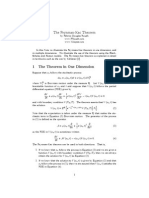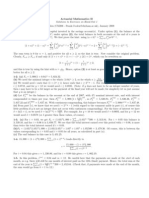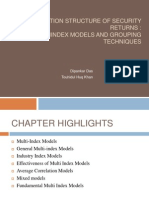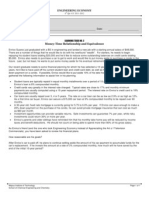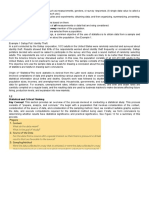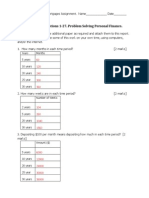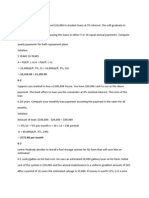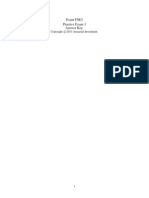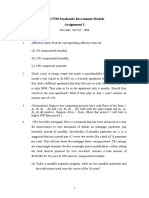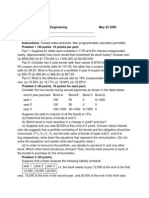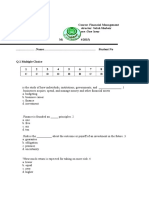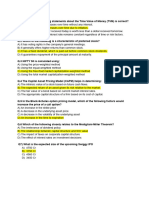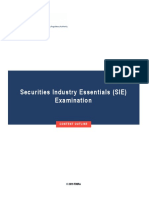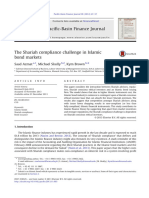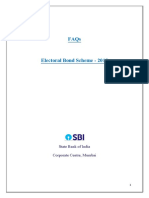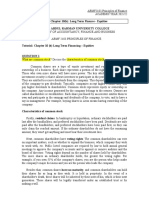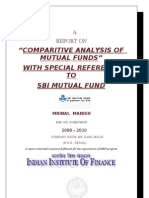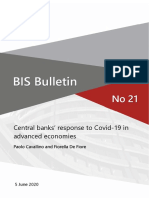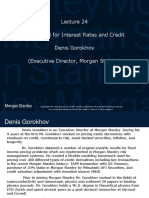Homework 01
Homework 01
Uploaded by
Tommy Chan Lui HoCopyright:
Available Formats
Homework 01
Homework 01
Uploaded by
Tommy Chan Lui HoOriginal Description:
Copyright
Available Formats
Share this document
Did you find this document useful?
Is this content inappropriate?
Copyright:
Available Formats
Homework 01
Homework 01
Uploaded by
Tommy Chan Lui HoCopyright:
Available Formats
SEEM 3590 Investment Science
Xuedong He, Fall 2016
Homework Set 1
(Due Sept. 21)
Reading
[L] Ch2: Section 15; Ch3: Section 18; Ch5: Sections 3, 4, 6.
([L] refers to Investment Science, 1st Edition by David Luenberger.)
Assignment
1. [L] Chapter 2: Exercise 6
(Sunk costs) A young couple has made a nonrefundable deposit of the first
months rent (equal to $1,000) on a 6-month apartment lease. The next day
they find a different apartment that they like just as well, but its monthly rent
is only $900. They plan to be in the apartment only 6 months. Should they
switch to the new apartment? What if they plan to stay 1 year? Assume an
interest rate of 12% and the rent is paid at the beginning of each month.
2. [L] Chapter 2: Exercise 8
(Copy machines) Tow copy machines are available. Both have useful lives of 5
years. One machine can be either leased or purchased outright; the other must
be purchased. Hence there are a total of three options: A, B, and C. The details
are shown in Table 2.6. (The first years maintenance is included in the initial
cost. There are then four additional maintenance payments, occurring at the
beginning of each year, followed by revenues from resale.) The present values of
the expenses of these three options using a 10% interest rate are also indicated
in the table. According to a present value analysis, the machine of least cost,
as measured by the present value, should be selected; that is, option B.
Table 2.6
Copy Machine Options
Initial outlay
Yearly expense
Resale value
Present value (@10%)
A
6,000
8,000
0
31,359
Option
B
30,000
2,000
10,000
30,131
C
35,000
1,600
12,000
32,621
Option A is a lease; options B and C are purchases of two alternative
machines. All have 5-year lives.
It is not possible to compute the IRR for any of these alternatives, because all
cash flows are negative (except for the resale values). However, it is possible to
calculate the IRR on an incremental basis. Find the IRR corresponding to a
change from A to B. Is a change from A to B justified on the basis of IRR?
1
SEEM 3590 Investment Science
Xuedong He, Fall 2016
3. [L] Chapter 2: Exercise 9
(An appraisal) You are considering the purchase of a nice home. It is in every
way perfect for you and in excellent condition, except for the roof. The roof
has only 5 years of life remaining. A new roof would last 20 years, but would
cost $20,000. The housing is expected to last forever. Assuming that costs will
remain constant and that the interest rate is 5%, what value would you assign
to the existing roof?
4. [L] Chapter 3: Exercise 4
(APR) For the mortgage listed second in Table 3.1 (see [L] or lecture notes on
mortgage calculation), what are the expenses in additional to the points?
5. [L] Chapter 3: Exercise 5
(Callable bond) The Z corporation issues a 10%, 20-year bond at a time when
yields are 10%. The bond has a call provision that allows the corporation to
force a bond holder to redeem his or her bond at face value plus 5%. After 5
years the corporation finds that exercise of this call provision is advantageous.
What can you deduce about the yield at that time? (Assume one coupon
payment per year.)
6. [L] Chapter 3: Exercise 6
(The biweekly mortgage) Here is a proposal that has been advanced as a way for
homeowners to save thousands of dollars on mortgage payments: pay biweekly
instead of monthly. Specifically, if monthly payments are x, it is suggested that
one instead pay x/2 every two weeks (for a total of 26 payments per year). This
will pay down the mortgage faster, saving interest. The savings are surprisingly
dramatic for this seemingly minor modificationoften cutting the total interest
payment by over one-third. Assume a loan amount of $100,000 for 30 years at
10% interest, compounded monthly.
(a) Under a monthly payment program, what are the monthly payments and
the total interest paid over the course of the 30 years?
(b) Using the biweekly program, when will the loan be completely repaid, and
what are the savings in total interest paid over the monthly program? (You
may assume biweekly compounding for this part.)
7. [L] Chapter 3: Exercise 10
(Duration) Find the price and duration of a 10-year, 8% bond that is trading
at a yield of 10%.
8. [L] Chapter 3: Exercise 11
(Annuity duration) Find the duration D and the modified duration DM of a
perpetual annuity that pays an amount A at the beginning of each year, with
SEEM 3590 Investment Science
Xuedong He, Fall 2016
the first such payment being 1 year from now. Assume a constant interest rate
r compounded yearly.
9. [L] Chapter 3: Exercise 12
(Bond selection) Consider the four bonds having annual payments as shown in
Table 3.9. They are traded to produce a 15% yield.
Table 3.9
End of year payments
Year 1
Year 2
Year 3
Bond A
100
100
100 + 1000
Bond B
50
50
50 + 1000
Bond C
0
0
0 + 1000
Bond D
0 + 1000
0
0
(a) Determined the price of each bond.
(b) Determined the duration of each bond (not the modified duration).
(c) Which bond is most sensitive to a change in yield?
(d) Suppose you owe $2,000 at the end of 2 years. Concern about interest
rate risk suggests that a portfolio consisting of the bonds and the obligation should be immunized. If VA , VB , VC , and VD are the total values
of bonds purchased of types A, B, C, and D, respectively, what are the
necessary constraints to implement the immunization? [Hint: There are
two equations. (Do not solve.)]
(e) In order to immunize the portfolio, you decide to use bond C and one other
bond. Which other bond should you choose? Find the amounts (in total
value) of each of these to purchase.
(f) You decided in (e) to use bond C in the immunization. Would other
choices, including perhaps a combination of bonds, lead to lower total
cost?
10. [L] Chapter 5: Exercise 7
(The fishing problem) Find the solution to the fishing problem of Example 5.4
when the interest rate is 33%. Are the decisions different that when the interest
rate is 25%? At what critical value of the discount factor does the solution
change?
You might also like
- 4831 S2016 PS2 AnswerKeyDocument9 pages4831 S2016 PS2 AnswerKeyAmy20160302No ratings yet
- Wooldridge - Computer Exercises, Chapter 3, C3, C9, C12Document4 pagesWooldridge - Computer Exercises, Chapter 3, C3, C9, C12Karina AndruschakNo ratings yet
- Ip-Opgaver 10.8Document13 pagesIp-Opgaver 10.8Tarique Hasan KhanNo ratings yet
- Investment Science.Document8 pagesInvestment Science.lizNo ratings yet
- The Feynman-Kac TheoremDocument7 pagesThe Feynman-Kac TheoremAshwini Kumar PalNo ratings yet
- Solution Manual For Investment Science by David LuenbergerDocument2 pagesSolution Manual For Investment Science by David Luenbergeryoogs0% (1)
- Sensitivity Analysis InterpretationDocument8 pagesSensitivity Analysis Interpretationronit brahmaNo ratings yet
- Actuarial Notation: AnnuitiesDocument12 pagesActuarial Notation: AnnuitiesCallum Thain BlackNo ratings yet
- Let Today Be November 3 2008 A Use The Libor RateDocument2 pagesLet Today Be November 3 2008 A Use The Libor RateAmit PandeyNo ratings yet
- PSS 1 Solutions - MGMT331Document11 pagesPSS 1 Solutions - MGMT331Svetlana PetrosyanNo ratings yet
- Solutions of Selected Problems in Chapter 4 - The Time Value of Money (Part 2)Document10 pagesSolutions of Selected Problems in Chapter 4 - The Time Value of Money (Part 2)Sana Khan100% (1)
- Revision Question Final - 1 - AnswerDocument6 pagesRevision Question Final - 1 - AnswerCrew's GamingNo ratings yet
- Actuarial Mathematics II Solutions To Exercises OnDocument4 pagesActuarial Mathematics II Solutions To Exercises Onshashalom77No ratings yet
- The Correlation Structure of Security Returns: Multiindex Models and Grouping TechniquesDocument26 pagesThe Correlation Structure of Security Returns: Multiindex Models and Grouping TechniquessaminbdNo ratings yet
- 10408065Document4 pages10408065Joel Christian MascariñaNo ratings yet
- AutocorrelationDocument172 pagesAutocorrelationJenab Peteburoh100% (1)
- Extra Exercises LPDocument5 pagesExtra Exercises LPIngrid MaurerNo ratings yet
- CHE40 LT#2-Money-Time Relationship and EquivalenceDocument1 pageCHE40 LT#2-Money-Time Relationship and EquivalenceVon Joby Romero0% (1)
- Special Cases of LPP: Chapter 6, Part A: Distribution and Network ModelsDocument39 pagesSpecial Cases of LPP: Chapter 6, Part A: Distribution and Network ModelsdsdfsdfsNo ratings yet
- Chapter 16: Fixed Income Portfolio ManagementDocument20 pagesChapter 16: Fixed Income Portfolio ManagementSilviu Trebuian100% (1)
- Chapter 8 Solution To Example Exercises PDFDocument3 pagesChapter 8 Solution To Example Exercises PDFShiela RengelNo ratings yet
- Simple and Compound Interest: Concept of Time and Value OfmoneyDocument11 pagesSimple and Compound Interest: Concept of Time and Value OfmoneyUnzila AtiqNo ratings yet
- 20201221203332YWLEE003Perfect Compyp SolutionDocument19 pages20201221203332YWLEE003Perfect Compyp SolutionDương DươngNo ratings yet
- 610 Quiz 1 S09 PDFDocument2 pages610 Quiz 1 S09 PDFTodsawat FluKeNo ratings yet
- Elementary Statistics Chapter 1Document15 pagesElementary Statistics Chapter 1Marion AlyssaNo ratings yet
- Reading 2 The Time Value of Money in Finance - AnswersDocument20 pagesReading 2 The Time Value of Money in Finance - Answersmenexe9137No ratings yet
- 0082 A Multi-Factor Model For Energy DerivativesDocument20 pages0082 A Multi-Factor Model For Energy DerivativesOureo LiNo ratings yet
- Monte Carlo SimulationDocument22 pagesMonte Carlo SimulationApurva AgrawalNo ratings yet
- Annuities Part 1 Answers q1-27 Mortgages and Personal Finance NsDocument6 pagesAnnuities Part 1 Answers q1-27 Mortgages and Personal Finance Nsapi-268810190No ratings yet
- PracticeDocument8 pagesPracticehuongthuy1811No ratings yet
- EECODocument2 pagesEECOabegaelbautistaNo ratings yet
- BKM CH 06 Answers W CFADocument11 pagesBKM CH 06 Answers W CFAAhmed Bashir100% (19)
- Krugman2e Solutions CH13Document12 pagesKrugman2e Solutions CH13amw4011100% (1)
- Midterm ReviewsDocument4 pagesMidterm ReviewsBách NguyễnNo ratings yet
- Partial Derivative and Its Economic ApplicationDocument21 pagesPartial Derivative and Its Economic Applicationsujay giriNo ratings yet
- Time Value of Money Notes Loan ArmotisationDocument12 pagesTime Value of Money Notes Loan ArmotisationVimbai ChituraNo ratings yet
- The Time Value MoneyDocument4 pagesThe Time Value Moneycamilafernanda85No ratings yet
- Exam FM Practice Exam 3Document71 pagesExam FM Practice Exam 3nad_nattNo ratings yet
- CH 02 Sec 02Document14 pagesCH 02 Sec 02datdude1415No ratings yet
- 1 Time Value of MoneyDocument85 pages1 Time Value of MoneySeth D'MelloNo ratings yet
- Chapter 2: Asset Classes and Financial Instruments: Problem SetsDocument5 pagesChapter 2: Asset Classes and Financial Instruments: Problem SetsSereyvuth NongNo ratings yet
- Unequal Lives DruryDocument3 pagesUnequal Lives DruryZahid HussainNo ratings yet
- 2024 Financial Derivatives Practice QuestionsDocument9 pages2024 Financial Derivatives Practice Questions24a4013096No ratings yet
- Chapter 12 Network ModelsDocument38 pagesChapter 12 Network Modelsvita sarasi100% (1)
- LESSON 7: Non-Parametric Statistics: Tests of Association & Test of HomogeneityDocument21 pagesLESSON 7: Non-Parametric Statistics: Tests of Association & Test of HomogeneityJiyahnBayNo ratings yet
- Econometrics Test BankDocument134 pagesEconometrics Test BankTrang Nguyễn Ngọc ThiênNo ratings yet
- FM2 NumericalsDocument38 pagesFM2 NumericalsKamalakar ReddyNo ratings yet
- ProblemsDocument4 pagesProblemsKritika SrivastavaNo ratings yet
- Lease Problems Hw1Document6 pagesLease Problems Hw1Vi NguyenNo ratings yet
- Time Value of MoneyDocument27 pagesTime Value of MoneyKhandoker FaisalNo ratings yet
- Annuities Part 2 Answers q28-39 Mortgages and Personal Finance NsDocument7 pagesAnnuities Part 2 Answers q28-39 Mortgages and Personal Finance Nsapi-268810190No ratings yet
- Solutions To Chapter 5 Valuing BondsDocument8 pagesSolutions To Chapter 5 Valuing BondsCandace WagnerNo ratings yet
- McDonald - ISM3e - Chapter 1Document6 pagesMcDonald - ISM3e - Chapter 1Jess LingNo ratings yet
- Chapter 10 - Aggregate Demand IDocument30 pagesChapter 10 - Aggregate Demand IwaysNo ratings yet
- Transportation and Assignment Model-LPDocument41 pagesTransportation and Assignment Model-LPShaina Aragon100% (1)
- Present Value 1Document7 pagesPresent Value 1shotejNo ratings yet
- Chapter 4 Exercises: Date Stock PriceDocument2 pagesChapter 4 Exercises: Date Stock PriceLy PhanNo ratings yet
- Solutions Manual to Accompany Introduction to Quantitative Methods in Business: with Applications Using Microsoft Office ExcelFrom EverandSolutions Manual to Accompany Introduction to Quantitative Methods in Business: with Applications Using Microsoft Office ExcelNo ratings yet
- Seg7530 Assg1Document2 pagesSeg7530 Assg1Gladys Gladys MakNo ratings yet
- SDF SDFDF 32 SDFDSF SDFDSFDocument2 pagesSDF SDFDF 32 SDFDSF SDFDSFDineshan PNo ratings yet
- Pepsi New LogoDocument16 pagesPepsi New LogoBobicmonNo ratings yet
- Richard A Posner Financial Disclosure Report For 2010Document10 pagesRichard A Posner Financial Disclosure Report For 2010Judicial Watch, Inc.No ratings yet
- Chapter 9: Credit Instruments ObjectivesDocument43 pagesChapter 9: Credit Instruments ObjectiveskatlicNo ratings yet
- Sample Chart of Accounts For A Large Corporation: Current AssetsDocument2 pagesSample Chart of Accounts For A Large Corporation: Current AssetsJay Dequilato TumaleNo ratings yet
- Chapter 1 - Updated-1 PDFDocument29 pagesChapter 1 - Updated-1 PDFj000diNo ratings yet
- Mid. Fm2014 20152 ادارة مالية باللغة الانجليزيةDocument5 pagesMid. Fm2014 20152 ادارة مالية باللغة الانجليزيةعبدالله ماجد المطارنهNo ratings yet
- Petrolera Zuata, Petrozuata CaseDocument8 pagesPetrolera Zuata, Petrozuata CaseAndy Vibgyor50% (2)
- 2102 Midterm 2 Study GuideDocument13 pages2102 Midterm 2 Study GuideMoses SuhNo ratings yet
- Engineering Econ and Financial ManagementDocument10 pagesEngineering Econ and Financial ManagementLoala SMDNo ratings yet
- Under The Gavel - Round 1 Quiz QuestionsDocument4 pagesUnder The Gavel - Round 1 Quiz QuestionsAditya DhirNo ratings yet
- Caluclation of VoidDocument8 pagesCaluclation of VoidفتىالصحراءفتىالصحراءNo ratings yet
- Sample Level I Multiple Choice Questions - Ethics 2Document23 pagesSample Level I Multiple Choice Questions - Ethics 2Fayad CalúNo ratings yet
- Lecture 1 The Investment EnvironmentDocument43 pagesLecture 1 The Investment Environmentnoobmaster 0206No ratings yet
- Guide To London Global Financial Centre 1861976321Document353 pagesGuide To London Global Financial Centre 1861976321Baigalmaa NyamtserenNo ratings yet
- Securities Industry Essentials (SIE) Examination: Content OutlineDocument15 pagesSecurities Industry Essentials (SIE) Examination: Content Outlinejay0% (1)
- Types of BondsDocument2 pagesTypes of Bondssnehachandan91No ratings yet
- JI - The Shariah Compliance Challenge in Islamic Bond MarketsDocument11 pagesJI - The Shariah Compliance Challenge in Islamic Bond MarketsRifaldy MajidNo ratings yet
- State Bank of India Corporate Centre, MumbaiDocument15 pagesState Bank of India Corporate Centre, MumbaiSHREYAS MAHAPATRANo ratings yet
- IPE-209 Ch-5 Evaluating A Single Project 2020Document47 pagesIPE-209 Ch-5 Evaluating A Single Project 2020Naymul HasanNo ratings yet
- Chapter 10b - Long Term Finance - EquitiesDocument5 pagesChapter 10b - Long Term Finance - EquitiesTAN YUN YUNNo ratings yet
- Question No. 1 Is Compulsory. Attempt Any Four Questions From The Remaining Five Questions. Working Notes Should Form Part of The AnswerDocument5 pagesQuestion No. 1 Is Compulsory. Attempt Any Four Questions From The Remaining Five Questions. Working Notes Should Form Part of The AnswercdNo ratings yet
- Comparative Analysis of Mutual FundsDocument222 pagesComparative Analysis of Mutual Fundsmrinal_ms85% (27)
- Invitation To Bid: General GuidelinesDocument30 pagesInvitation To Bid: General GuidelinesJohn Paul GuarinNo ratings yet
- Essay AAS Supporting StatementsDocument2 pagesEssay AAS Supporting StatementsMartinho Savio Gonzaga SarmentoNo ratings yet
- Financial Accounting Chapter 13Document59 pagesFinancial Accounting Chapter 13Waqas MazharNo ratings yet
- Finance Chapter 16Document42 pagesFinance Chapter 16courtdubs67% (3)
- Black BookDocument28 pagesBlack Bookkhushbu RanaNo ratings yet
- BIS Bulletin-Central Banks' Response To Covid in Advanced EconomiesDocument9 pagesBIS Bulletin-Central Banks' Response To Covid in Advanced EconomiesGABRIEL ALEXANDER ROLDAN SANCHEZNo ratings yet
- Parivartana Yoga IIDocument35 pagesParivartana Yoga IIGauravNo ratings yet
- 1.3 Interest Rates and Price Volatility (Oct 28) PDFDocument58 pages1.3 Interest Rates and Price Volatility (Oct 28) PDFRedNo ratings yet




